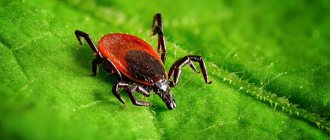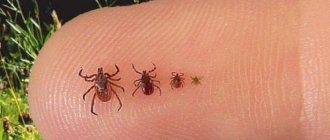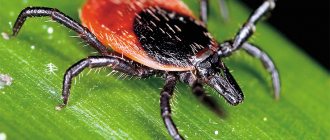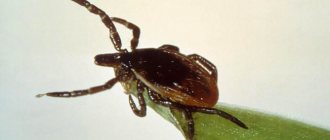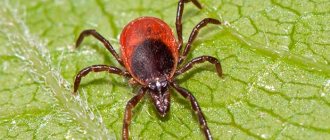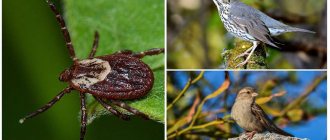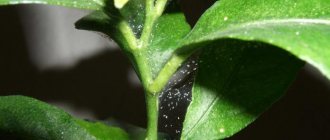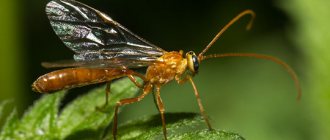With the onset of spring warmth, pleasant walks in a park or forest can be overshadowed by a tick bite, not only of the person himself, but also of the pet walking with him. To protect yourself and your animals from tick attacks, it is better to have an idea of where ticks live and how they reproduce.
A simple understanding of what places parasites live in, how they reproduce, how long the attack process lasts, will help minimize encounters with bloodsuckers and the harm it promises.
Where do ticks live: types and distribution
Forest ticks are small in size, reaching a length of 2-5 mm in a hungry state. Such arachnids belong to the subclass of arthropods and live almost all over the world, except Antarctica. The diversity of parasite species differs depending on the place of their life activity and the nature of their feeding.
Ixodid ticks, numbering almost 700 species, prefer to settle in damp forests, densely overgrown grassy meadows, and on low trees and shrubs. In nature, their diet consists of plant debris, soil fungi and small arthropods, but they also love to drink the blood of animals and people.
There are other types of such parasites:
- gamasid, red beetles and argasid mites, which are also capable of consuming human and mammalian blood;
- dust mites (saprophytes), whose life is spent in living quarters with people, prefer to feed on dead particles of the epidermis;
- subcutaneous (Demodex) - live in the upper layer of the human epidermis and at the base of the hair follicles; they are tiny in size, so they can only be seen under a microscope.
Is it possible to protect yourself from tick-borne encephalitis?
Prevention of the disease consists of providing anti-tick protection to humans and increasing the body’s resistance to the pathogen. Anti-tick protection methods are divided into individual and collective.
Personal protective equipment.
When visiting the forest, it is necessary to strictly observe conditions that prevent ticks from crawling and penetrating under clothing. For this purpose, you need to wear special protective clothing - a jacket with a hood and trousers made of thick fabric. You can turn ordinary clothing into protective clothing if you button the collar and cuffs tightly, tuck the shirt into trousers, and the trousers into boots or socks, and put a hood over your head. But it is difficult to work in such a suit in hot weather. And yet, where it is absolutely necessary, such clothes must be worn.
During the day, it is necessary to conduct thorough self- and mutual examinations every 1-2 hours. This measure is simple, reliable and accessible to everyone. During examination, special attention should be paid to the hairy parts of the body, skin folds, ears, armpits and inguinal cavities. When returning home, you need to carefully examine all the folds and seams of your clothing, as ticks may crawl into them without having time to attach themselves. And only after making sure that there are no ticks can you go indoors. It is better to leave the suit and boots outside the living space. It is recommended to change your underwear at home, and take off what you have removed from the living rooms to the balcony, into the barn, or fill it with warm water and wash it. It's nice to take a shower. These simple and effective measures are available to everyone.
Well, if, despite taking precautions, the tick still sticks, how can you remove it along with the head? To do this, you need to lubricate the tick and the area of skin around it with cream, Vaseline, vegetable oil, any fat, and after 30-60 seconds, tilting the tick to the back side, grab it close to the skin with tweezers (you can use two fingers - thumb and forefinger) and quickly, pull out with a sharp movement. The fat closes the breathing holes, and the tick relaxes the muscles of the proboscis for some time. It can be painlessly removed along with the head, which is very important, since the remaining part of the tick’s body can cause an inflammatory process.
But the most reliable method of removing a tick is to go to the emergency room of a medical institution.
All ticks found on the body, not attached and removed from the skin, must be destroyed: they are placed in any disinfectant solution (Lysol, kerosene, alcohol, etc.) or burned.
Never crush ticks with your hands! Splashes of the cavity fluid and salivary glands of the tick can get on the mucous membranes of the mouth, nasal cavity, small wounds on the skin of the hands and cause tick-borne encephalitis. After removing the tick, wash your hands thoroughly.
Following these simple and accessible techniques will help you reliably protect yourself from tick-borne encephalitis.
Along with protective clothing, there are special deterrent chemicals called repellents. Reftamid Taezhny, Raptor, DEET, etc. have proven themselves well. To protect a person from blood-sucking arthropods, repellents are applied to exposed areas of the skin - face, neck, hands.
Recently, another, more convenient and safer method has been increasingly used - impregnating clothing and head coverings with repellents. On clothing, the drugs retain their repellent properties much longer than when applied to the skin. However, it should be remembered that negative reactions of individuals to repellent odors do occur. Some of them irritate the integument, mucous membranes and cause other side effects. Therefore, it is necessary to use repellents strictly following the rules for their use.
Habitats of ixodid ticks
Optimal living conditions where ticks are found:
- regions with high humidity, at least 80%;
- sun-warmed slopes with thick grass and shrubs up to 1 m high;
- The main habitat of ticks is: forest edges, clearings, ravines with dense grass;
- in the shade of deciduous trees there are thickets of ferns, among low young trees (aspen, hazel, etc.);
- Parasites most often live in coastal thickets near rivers, ponds, lakes and streams, where forest animals come to drink;
- soil surface with fallen leaves or mown grass.
Ticks in nature
Interesting!
“Bloodsuckers” can settle on stumps and fallen dry trees, so a tourist should think carefully before sitting down to relax in the forest on the first stump he encounters.
The most unsuitable places for ticks to live: hills, areas without grass and plants, dry undergrowth in a pine forest, etc.
Myth 6: to remove an attached tick, you need to lubricate the bite site with sunflower oil.
In fact, waiting for the tick to come out on its own is a pointless exercise. It is much better to use a special device with a small loop at the end (you can buy it in tourist goods stores, for hunting and fishing). Another way is to make a loop of thread, wrap it around the proboscis, twist it and gently pull, as if twisting a tick. You can use tweezers for the same purposes. The main thing is that the proboscis does not remain in the body of the bitten person.
Where to submit a tick test in the Krasnoyarsk Territory:
- Achinsk, st. Tolstoy, 23; — Lesosibirsk, st. Mira, 5; - Minusinsk, st. Komarova, 1. - Sharypovo, 2 microdistrict, 8/4 - Kansk, st. Edeymana, 9 - Zaozerny, st. Mira, 54, room. 27 - Balakhtinsky district, Balakhta village, st. Sovetskaya, 113a.
After removing the tick, do not throw it away, but put it in a tightly closed jar and hand it over:
- st. Sopochnaya, 38. Open Monday to Friday from 8:00 to 19:00, on weekends from 9:00 to 16:00;
- st. Lenina, 168. Open from Monday to Friday from 8:00 to 19:00, on weekends from 9:00 to 16:00;
- st. 26 Baku Commissioners, 29. Open Monday to Friday from 8:00 to 17:00.
After a few days, they will tell you over the phone whether the tick was infected or not. It is also worth taking ticks there that have not yet burrowed into you, but were simply sitting on the skin, as well as those that you removed from your pet.
In addition, there is an option to take the tick to one of the five Krasnoyarsk points of the Federal Siberian Scientific and Clinical Center of the FMBA of Russia. They can do the analysis without waiting in line, free of charge under a VHI policy, or for a fee if you are not insured against a tick bite.
Types of ixodid ticks: which forests do they live in?
Among the family of ixodid parasites, there are some species that choose different habitats:
- Meadow ticks of the genus Dermacentor are carriers of many viral infections and can infect humans and even pets (pyroplasmosis in dogs). Distributed in areas of deciduous and mixed forests in Europe and Siberia, preferring clearings, forest edges, meadows and pastures, water meadows.
- The genus Hyalomma and its representatives prefer to settle in the steppe zone, living in the southern regions of Russia, Crimea, Bulgaria and on the Mediterranean coast, in Asian countries. They can spread hemorrhagic fever.
- Birch mites, belonging to the Haemaphysalis family, are moisture- and heat-loving parasites; their habitat is: Crimea, Transcaucasia and the Far East, Altai, the southern part of Western Siberia and Transbaikalia. They settle in birch-deciduous, coniferous-deciduous, aspen and birch forests. They can be carriers of encephalitis and rickettosis.
- The brown dog tick of the genus Rhipicephalus prefers coastal areas with high humidity: the Black Sea coast. The objects of its attack are often dogs, but the spread of dog ticks occurs very quickly due to their ability to reproduce in a person’s home or dog kennel, where they can establish entire colonies. They are carriers of Marseilles fever.
What are ticks
Ticks are just small arachnid arthropods that have lived for millions of years and inhabited the Earth long before humans appeared on it. Therefore, it can be argued that as long as a person lives, he is accompanied by bites from representatives of this family.
Ticks can rightly be classified as faithful and constant companions of all living things - for millions of years, where there is vegetation or living creatures, these spiders can be found from hot Africa to the harsh taiga of the Eurasian continent, from deserts to rainforests.
That is, it is difficult to find a place on the planet where ticks do not live.
A misconception is the belief that all ticks are parasitic and drink blood, much less live on humans or animals. In fact, of the 48,000 species known in scientific circles today, only the order Ixodida, numbering over 900 representatives, prefers the blood of humans, warm-blooded animals, birds and even reptiles as food.
There is a separate family of tiny parasites that penetrate the skin and constantly parasitize inside the body of animals and people, but the spread and reproduction of such mites largely depend on basic hygiene. The rest of the ticks live in various types of vegetation, feed on plant components, organic matter, their relatives or their remains, posing no threat to humans.
Which ticks are dangerous to humans and pets?
People, fearing for their own health and for the well-being of their animals, should have information about those parasites that carry a real risk of developing dangerous infections. There are conditionally 2 types of such mites - permanent and temporary parasites.
Constant parasites
These tiny arachnids, burrowing under the skin of warm-blooded animals and humans, live there constantly, that is, throughout their entire life cycle, causing undeniable harm through their own vital activity.
Such diseases are usually called acariasis.
As a rule, acariasis is caused by the following permanent parasites:
- Ear mites affecting the outer ear and ear canal.
- Scabious itching affecting the subcutaneous layers.
- Demodicosis, when the face and the area around it are mainly affected.
Prevention consists of strict adherence to hygiene rules, especially where such ticks and their carriers live.
Temporary Parasites
The only order that, during its own evolution, transformed into the form of temporary parasites is Ixodida. Only two families of this order - Argasidae and Ixodidae - pose a real threat with their bites to people and domestic animals.
Because they are able to climb onto a victim, pierce the skin, drink blood and thereby provoke a number of serious problems.
It is their accidental bites, possible during walks and trips into nature, that people rightly fear, wanting to avoid the following unpleasant and sometimes dangerous moments:
After saturation, the process of which can last for a week in an adult female, and several hours in a male, the bloodsucker falls off on its own. If the parasite is not detected and removed in time, it will suck blood as much as it needs.
Argasid mites
Not all representatives of argasid mites are capable of causing harm with their attacks in our region; residents of South America suffer from the majority of them. In our latitudes, the most likely danger from this family is the following representatives:
- The village tick, which lives near large livestock and poultry, parasitizes them, transmitting the pathogens of borelliosis and relapsing fever to humans when biting them.
- The shell mite, which most often lives in pigeon nests and parasitizes pigeons, the bite of which causes severe allergies in humans; also suspected of carrying Q fever.
These bloodsuckers are interesting to scientists because of how long the tick lives without feeding. About 10 years! During forced hunger, the parasite goes into hibernation, and all life processes slow down. But when a source of food appears, activation quickly occurs and the tick is ready for an immediate attack.
In reality, argas parasites rarely attack people, since they still prefer more familiar hosts.
With the onset of periods of hunger, they are capable of migrating over long distances on the body of the victim, attaching themselves to it. This is especially true for birds that carry ticks for several thousand kilometers.
Hunting season of "bloodsuckers"
The period of parasite activity begins when the soil warms up to +5-+7°C, which in central Russia occurs in April, when the first greenery appears and buds bloom on birch trees. Waking up after winter, they crawl to the surface.
Ticks are located on trees, grass, and bushes. Their numbers increase sharply by the second half of May and remain at their highest until the end of June. Activity depends on temperature and weather conditions, humidity. They do not like hot and dry air, so they go out to hunt in the morning and evening hours. On hot days they settle down in damp grass; in cloudy weather they look for drier places.
Ticks in nature
On a note!
The first season of active “hunting” occurs in spring and early summer, after which there is a lull. During this period, the ticks have already eaten and “rest” until the beginning of August. The duration of this period depends on the weather: if the beginning of summer is cool and humid, then the “spring season” becomes longer, and if it is dry and hot, it becomes shorter.
The autumn outbreak of activity, during which ticks try to get enough before wintering, begins in September and continues until the first days of November, when cold weather sets in.
First victims
Warm spring days are not only a time for walks in nature, barbecues and the beginning of the summer season, but also the period of greatest activity of dangerous insects. It usually lasts until the end of summer, but the peak occurs in April-June. The year before last, in many regions there was simply an abnormal invasion of ticks. This was facilitated by a fairly warm winter with little snow.
Spring also turned out to be favorable, there was a lot of greenery and sunny days. What every living thing needs. So, when going out of town, to the country house or to the park, you need to remember the simplest safety measures.
Every year, epidemiologists in most regions of the country, long before the onset of spring, begin to warn about the need to get vaccinated against tick-borne encephalitis. They have been preparing for the dangerous spring-summer season since the fall. Unfortunately, not all diseases transmitted by ticks can be vaccinated against.
Vaccines have not yet been invented for tick-borne borreliosis (TB) and Crimean hemorrhagic fever (CHF), and it is very easy to catch this infection. Judge for yourself: after the May holidays, according to Rospotrebnadzor, 39,165 people from 70 regions visited the country’s hospitals after tick bites, including 11,320 children.
And each region has its own danger. Tick-borne encephalitis can be caught almost throughout the entire territory of Crimea, in Siberia, in the North-Western District, St. Petersburg and Karelia, the Volga region, and many regions of the Central District. In the Moscow region and Moscow, as well as in the Krasnodar Territory, tick-borne borreliosis is more dangerous. In other southern regions - in the Rostov region, Volgograd region, in the Caucasus, you can catch hemorrhagic fever. So, when going on a summer vacation, you need to take this into account.
For example, during the May holidays of 2016, the highest number of tick bites was recorded in the Sverdlovsk, Kemerovo, Irkutsk, Tyumen, Irkutsk, Tomsk, Vologda, Leningrad regions, Krasnoyarsk, Altai and Primorsky territories.
11 cases of tick-borne encephalitis were registered in the Pskov, Irkutsk, Novgorod regions, Krasnoyarsk Territory, and the Republic of Khakassia and 11 cases of Crimean hemorrhagic fever in the Rostov region. There are two deaths. Most of them were infected with tick-borne borreliosis. 84 cases of ITB have been registered in the Kaliningrad, Moscow, Lipetsk, Belgorod, Kaluga, Vologda, Samara, Sverdlovsk, Irkutsk, Tyumen regions, in Udmurtia, the republics of Tatarstan, Tyva, Krasnodar and Transbaikal territories and St. Petersburg.
As experts say, despite the fact that in Moscow and the Moscow region, St. Petersburg and other large cities, forested areas are annually treated with acaricidal preparations, it is still impossible to protect all green areas. According to the Office of Rospotrebnadzor for the city of Moscow, last year ticks carrying borreliosis were found in some of the most crowded parks: in Kuzminki, Serebryany Bor, on Losiny Island, in Izmailovsky, Krylatsky, in the forest area of Zelenograd and even Ekaterininsky.
After the May holidays the year before last, 1,296 people with tick bites, 234 of them children, have already contacted medical organizations in Moscow. In the laboratory of the Center for Hygiene and Epidemiology, specialists examined 296 ticks and 21 of them were infected with tick-borne borreliosis. According to statistics from experts, usually 10 to 20% of the total number of insects are infected with Borrels. But tick-borne encephalitis in the Moscow region can only be caught in the Taldomsky and Dmitrovsky districts, as well as in neighboring regions - Tver, Ivanovo, Kostroma.
Hunting process
Forest ticks live in grass or trees, climbing to low heights and tracking down their prey. With the help of their paws, on which the olfactory organs are located, they sniff the surrounding air. They can smell the sweat of an animal or person walking along a path from a distance of 10-12 m.
On a note!
Some people mistakenly believe that such parasites fall from trees in the forest onto tourists passing by. However, in reality they are not able to climb a great distance from the ground; usually ticks can be at a height of up to 0.5-1 m.
When the “prey” approaches, they move onto it, grasping tightly with their suction hooks. Then they begin to climb up and look for a place to bite, usually choosing areas of the head or neck in animals; in people, areas with thin skin and close proximity of blood vessels.
Both males and females go hunting, and the latter are more voracious, because for them the blood of mammals is not just food, but also affects the possibility of successful reproduction.
Males dig into the skin, drink blood, and then quickly fall, so a person may not notice them. But the females, sucking very tightly, sit and absorb blood for many hours and days. When the tick pierces the skin, it secretes anesthetic saliva, which glues the proboscis to the wound for better attachment.
Lifestyle
Ixodid ticks are sedentary arthropods that lead a rather monotonous life. Their main task is to first transform into an adult and then participate in the reproduction of offspring. Both for development and for reproduction, ticks need fresh blood - that’s why they attack warm-blooded people and animals.
The bloodsucker also hunts as passively as possible, taking a good position and waiting until the prey passes by. A tick can spend more than one day waiting, but it rarely goes looking for food.
Mite
Are there ticks in the city?
The widespread belief that city residents may not be afraid of tick bites is refuted by scientific data and statistics of victims. In every locality and even a large metropolis there are park areas, squares and areas sown with grass. These are the places where ticks live in the summer. Scientists cannot answer the question of how they get there, but sanitary services find them there.
Ticks in nature
Parasites prefer to settle not only on low bushes and trees in parks, but also on lawn grass. However, unlike forest ticks, in large cities there are practically no individuals infected with viral infections.
But in small settlements, where green areas are located near forests, fields with livestock or summer cottages, ticks can be picked up almost on the road or next to the lawn, and the danger from them is small, but still exists.
Periods of tick activity
Ticks, inhabitants of the temperate climate zone, are characterized by spring-summer-autumn activity. In the conditions of the Urals, taiga and European forest ticks become active in early spring. With the onset of stable positive air temperatures (+3° and above), ticks can be found in the first thawed patches, on last year's grass, heaps of brushwood and dead wood. In the third ten days of April, and in some years already at the end of the first ten days, active individuals appear. The taiga tick is active until the end of June, sometimes found singly in July.
The European forest parasitizes in nature from April to the end of September, and individual individuals can be found on animals (hunting dogs) in October and even November.
The most dangerous “tick” months in our conditions are the end of April-July. During this period, it is necessary for everyone who visits the forest or works there to observe personal preventive measures and prevent ticks from attacking and sucking on them.
Why are ticks and their bites dangerous?
Among the ixodid species living in the Russian Federation, 2 species pose a danger to humans:
- European forest, distributed throughout Europe, except for the northernmost regions, in North Africa and the European part of Russia;
- taiga tick, whose habitat is in the middle and southern taiga.
These parasites are carriers of dangerous infectious diseases: viral encephalitis, Lyme disease or borreliosis, ehrlichiosis, and some types of fevers. However, this does not mean that every tick that bites can infect a person.
Important!
According to statistics, the percentage of “bloodsuckers” who carry infections is only 1.5-5%. However, it is impossible to externally distinguish a healthy tick from an infected one, and due to the long incubation period of such diseases, the first symptoms of the disease may appear only after 5-14 days.
Regions where there are the most ticks with a high risk of disease:
- borreliosis - Moscow and Moscow region, Krasnodar region;
- dangerous areas regarding encephalitis - the North-West of the Russian Federation, the Volga region, Karelia, the regions of the Central District, the Far East, the most cases are registered in Vladivostok and the region;
- hemorrhagic fever – Volgograd, Rostov regions, Caucasus.
According to Rospotrebnadzor, this year you can find regions where there are no encephalitis ticks in Russia. These are the central regions of the European part, including Moscow, Tula, Kursk, Oryol, Ryazan, Smolensk, Lipetsk, Tambov, Murmansk regions, Southern and North Caucasus federal districts, Magadan region, Kamchatka Territory, Yakutia and Chukotka.
Diseases from ticks
Appearance of the parasite
The popular belief that a tick is an insect is completely wrong. In fact, this parasite is an arachnid.
The length of a tick is usually no more than three millimeters. The average length of the parasite is even less: 0.1-0.5 millimeters. Does a tick have wings? Just like any arachnid, the parasite has no wings at all. However, adult individuals have four legs, while forest ticks that have not reached puberty can boast only three.
It is interesting that the tick does not only have wings: the bloodsucker also does not have eyes. This does not prevent them from being able to navigate the terrain well, due to their very developed sensory apparatus. It is thanks to their developed senses that forest ticks can smell a possible victim at distances that are large for their size - ten meters.
Ticks can be divided into separate sections:
Leatherbacks with fused head and chest. They inhale air using the trachea and skin. Photos of the tick are presented below
Armored with a head attached to the body. Breathing in this species is possible with the help of special spiracles. Photos of the tick are presented below
How are viral infections spread by ticks?
Ixodid ticks become carriers of infections after their larvae or nymphs drink blood from wild animals (small rodents, etc.), which are carriers of serious diseases. The encephalitis virus, first entering the stomach of the parasite from a sick rodent or other mammals, spreads throughout the body and accumulates in the salivary glands and eggs.
From an infected female, pathogens of infectious diseases are transmitted to all offspring. Infection of a person occurs during a bite when the tick injects saliva with the virus under the skin.
Important!
You should also know that the same parasite can be a carrier of several infectious diseases that reach a person as a result of its bite.
Why you need to watch out for ticks
Of all the diseases that ixodid ticks carry, three are the best known and most dangerous. Two are human and one is most dangerous for animals.
Tick-borne encephalitis
The disease does not appear immediately, and the mite on the skin is not immediately noticeable. After a parasite bite, this dangerous virus enters the bloodstream, it affects the central nervous system and the consequences can be very tragic. Manifested by fever, intoxication, severe weakness, the course resembles the flu.
Borreliosis
An infectious disease that occurs after a bite. At an early stage, it manifests itself as a rash in the form of erythema migrans, and after a few weeks neurological, cardiac and rheumatological complications appear. Treated with antibiotics.
Piroplasmosis
Sick dogs can barely move due to weakness in the hind limbs, their temperature rises, diarrhea and vomiting mixed with blood appear. The disease usually ends in death.
Safety and protection measures against ticks
When going on a picnic or a walk in the forest, where ticks may be located, you should remember that they can crawl only in the bottom-up direction, and select the appropriate equipment:
- clothes should be light-colored, as closed as possible, with long sleeves;
- trousers should be tucked into socks or shoes, cuffs should fit tightly to the arms so that parasites cannot crawl closer to the body;
- a hood or a protective headdress is put on the head: although ticks do not fall from trees, if they fall on the hair while bending the body or on a sitting person, they can live there for some time, and then go down to the neck and attach themselves to absorb blood;
- use repellents to treat clothes that repel parasites with smell;
- avoid clearings in the forest with tall grass, bushes, fallen trees and stumps;
- choose places for a picnic where there are no ticks: with short dry grass, in a pine forest without undergrowth, etc.
- After returning home, you should carefully inspect all clothing and skin for the presence of parasites.
Information about where ticks can live and how they get on human skin will be useful for all people who are going for a walk in the forest or park, to the country house or to a picnic. Compliance with all safety rules will help avoid attacks by “bloodsuckers” and possible infection with serious infectious diseases.
Ways of infection with tick-borne encephalitis
Tick-borne encephalitis is an acute viral disease primarily affecting the nervous system. The most significant changes occur in the brain. That is why the disease is called “encephalitis” (encephalon in Greek means brain), and the ending “itis” means the development of an inflammatory process.
Humans are infected with encephalitis through the bite of pasture ixodid ticks. The disease has a clearly defined seasonality, which is due to the spring-summer activity of vectors.
If a tick infected with the tick-borne encephalitis virus has attached itself to a person, the first signs of the disease appear within 7-14 days from the moment of attachment. I am worried about headaches in the frontotemporal region, lethargy, weakness, mild pain in the lower back, arms, and sometimes in the legs. In acute cases, the disease begins suddenly, with a sharp increase in temperature to 39-40°. Redness of the skin and visible mucous membranes is often observed. Meningeal symptoms occur as the meninges become irritated and the neck and arm muscles become stiff.
The disease occurs with high fever for 5-8 days. In the case of a severe course of the disease, on the 2-3rd day signs of focal damage to the nervous system are detected - weakness in the muscles of the arms and neck, a crawling sensation and numbness in them. Subsequently, these muscles become thin and “lose weight.” Some patients experience seizures, blurred vision and hearing.
Partial or complete restoration of muscle function develops slowly over 3-5 years. With deep disorders, the restoration of motor function in patients occurs insufficiently, and they remain disabled for life.
Any person who is temporarily or permanently in places where tick-borne encephalitis is registered can become ill. Most often, people whose profession is related to working in the forest get sick - employees of forestry enterprises, forestry enterprises, chemical forestry enterprises, geologists, surveyors, biologists, and signalmen. Cases of the disease have also been reported among fishermen and hunters. The incidence of tick-borne encephalitis among tourists and people vacationing in the forest has increased noticeably. There are known cases of ticks being carried into rooms with bouquets of flowers. They can move from the clothes of one person to the clothes of another who has returned from the forest. Sometimes ticks crawl from cows to milkmaids during milking. But in all cases, infection occurs only with the participation of a tick infected with the encephalitis virus.
There is another way of infection - drinking raw milk from goats that graze in places where there are a lot of ticks.
You can get tick-borne encephalitis if you try to crush ticks with your fingers, the skin of which has microcuts or cracks.
Susceptibility to tick-borne encephalitis varies from person to person. In natural foci of tick-borne encephalitis, local residents get sick much less often than newly arrived people. Long-term residence in a natural focus is accompanied by the emergence of immunity (immunity) to the disease in people. This is due to the fact that local residents often visit forest areas - in order to collect medicinal herbs, early berries, prepare brooms, fishing, etc. and are often exposed to ticks. With such repeated, albeit short-term, suctions, small doses of the virus can enter the human blood, which do not cause disease, but contribute to the formation of antibodies to this virus in the blood. The accumulation of antibodies ensures a decrease in susceptibility to encephalitis. If such people become infected, the disease occurs in a mild form, without severe complications, and after recovery, the body develops immunity to encephalitis, which lasts for a long time, fifteen years or more, and sometimes for life.
All age groups are susceptible to tick-borne encephalitis, but children, especially schoolchildren, are more often affected.
The duration of blood sucking is of great importance. The earlier a tick is detected and removed, the less virus enters the human body.
Description of the spider mite
The pine parasite has microscopic body sizes - no more than 0.6 mm in females and 0.45 mm in males. Adults are small grey-green spiders. They quickly crawl along leaves and webs in a chaotic manner. Their larvae look like underdeveloped translucent adults. The pest's appetite at all stages is excellent.
Females, producing offspring all summer, can hide in the bark of pine trees for the winter in the fall. If the winter was mild, then they survive safely until spring and continue their active activities. Parasites have no natural enemies. Birds are not interested in such small inhabitants of the pine forest. In addition, getting to them through the prickly needles is not so easy.
Spruce spider mites
Structural features
The tick has 4 pairs of legs and a strong shell. The female is larger than the male. It is able to stretch greatly in the back to saturate with a large volume of blood. Males attach themselves to the victim for a short time, no longer than an hour.
The male's life ends immediately after fertilization. One male individual fertilizes several females. Before laying eggs, the female needs increased blood nutrition. She leaves eggs at a height of up to half a meter above the ground. After transformation into a larva, the search for a host animal begins; the parasites will not be picked, and cattle will be the first to suffer. It is used for food for two years, which is how long it takes until an adult tick appears.
Ticks have increased vitality. They can go without food for several years.

